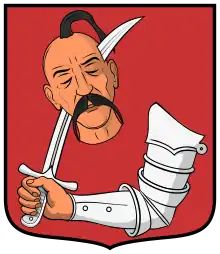Turk head (heraldry)
In European heraldry, the decapitated Turk head (Hungarian: Törökfej, Polish: Turecka głowa, Czech and Slovak: Turecká hlava, Serbo-Croatian: Turska glava, Турска глава, Ukrainian: Турецька голова, romanized: Turetska holova), most often as pierced by a sword, signifies the many wars fought by European Christian states against the invading Muslim, Turkish-led Ottoman Empire. Other depictions include the head held up by a victor or picked by a raven. It is used in modern town, municipality and village coat of arms in Hungary, Serbia and Croatia.

Coat of arms of the Hungarian town Komádi.
List
Cities and towns
Families
It was adopted by some Austro-Hungarian nobility, such as:
- The Balogh of Nemčice (in Slovakia), Mezőcsávás (in Romania), Csegö (?), Szász-Czegö (?)
- The Schwarzenberg of Český Krumlov (in Bohemia)[1]
- The Baky
- The Benkeö of Kezdi-Sarfalva
- The Csernovics
- The Csernoevicz
- The Csokits
- The Dunca of Sajo
- The Eperjessy of Gyulafehérvár (in Romania)
- The Kajdachy
- The Karácson
- The Kovács
- The Kruchió
- The Latinovics
- The Nagy
- The Okolicsányi
- The Pótsa
Gallery
.svg.png.webp) Schwarzenberger family arms with a crow pecking at a Turk's head
Schwarzenberger family arms with a crow pecking at a Turk's head Arms of the town of Orlík nad Vltavou, Czech Republic
Arms of the town of Orlík nad Vltavou, Czech Republic The coat of arms of the Balogh family from Mezőcsávás
The coat of arms of the Balogh family from Mezőcsávás Arms of the town of Hajdúdorog, Hungary
Arms of the town of Hajdúdorog, Hungary Arms of the town of Tépe, Hungary
Arms of the town of Tépe, Hungary Arms of the city of Kikinda, Serbia
Arms of the city of Kikinda, Serbia Arms of the town of Derecske, Hungary
Arms of the town of Derecske, Hungary
See also
Wikimedia Commons has media related to Turk head (heraldry).
References
- Charles Stickney (May 2001). World Enough: Travel Memoirs. iUniverse. p. 23. ISBN 978-0-595-18474-3.
Further reading
- Palmira Brummett (19 May 2015). Mapping the Ottomans. Cambridge University Press. pp. 209–. ISBN 978-1-107-09077-4.
This article is issued from Wikipedia. The text is licensed under Creative Commons - Attribution - Sharealike. Additional terms may apply for the media files.